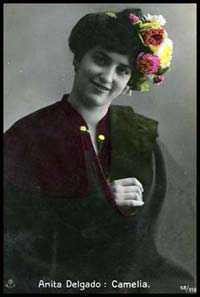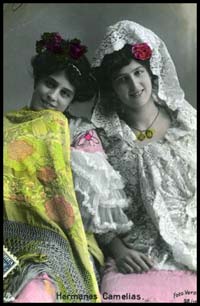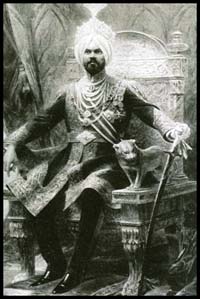By
Benigno Macías, the introduction of tango in Europe

had no news of this young Argentine landowner who spent the longest part of his life in Europe until my friend, the female Coruña writer Elisa Vázquez de Gey, mentioned him in one of her thoroughly documented books about Anita Delgado, the beautiful Malaga dancer that married to Jagatjit Singh (1872-1949), the seventh maharajah of Kapurtala.
 Seemingly, coming from Paris, Benigno Macías had arrived in Madrid on a date prior to the wedding of Alfonso XIII with Victoria of Battenberg (April 3, 1906) where he met, among many other figures of the great world, the maharajah.
Seemingly, coming from Paris, Benigno Macías had arrived in Madrid on a date prior to the wedding of Alfonso XIII with Victoria of Battenberg (April 3, 1906) where he met, among many other figures of the great world, the maharajah.
Known is the sensational story about how fascinated the man from India was by the beauty of the Malaga girl Anita, a simple support dancer of the Kursaal where she used to appear together with her sister Victoria under the name Las Camelias or Hermanas Camelia. With both stage names they appeared in the programs and postcards of that time. Also known is the fantastic story of the involvement of Valle-Inclán and the painters Julio Romero de Torres, Ricardo Baroja and Anselmo Miguel Nieto in the happy ending of the story.
They all frequented the above amusement place —pelota court by daylight and temple of variety shows by night— and, besides the maharajah, it was also visited by many of the personalities arrived in Madrid for the royal wedding. Among them, Benigno Macías must have been because he befriended with the above painters and, it seems he hopelessly fell for Victoria Delgado. Benigno met Victoria in Paris when Anita’s family travelled to the French capital to accompany her for the time the education prepared by the Indian prince for the princess would last. He married her in his kingdom on January 20, 1908.
Benigno Macías, son of an important landowner, was born in 1882 and, like most of the wealthy Argentine young men, had to travel to Paris at a time that coincided with the beginning of the twentieth century. Key date, then, for the early relations of Europe with the tango criollo of which Benigno succeeding in being one of its first ambassadors.
(Director’s Note: Let us remember the arrival in Paris of Ángel Villoldo and the Gobbis in 1907, invited by the Gath & Chaves company. Later, in 1911, Enrique Saborido and Carlos Vicente Geroni Flores arrived. And, finally, the third delegation of 1913 that included Celestino Ferrer, Eduardo Monelos and Vicente Loduca along with the dancer Casimiro Aín and his female partner Martina).
 According to the memoirs of Anita Delgado, the maharani of Kapurtala, we know that, when he arrived in Spain he tried to introduce tangos into the variety theaters. But we have been unable to find out anything about it and we think it was too soon because, by then, tango was not common in Paris yet. Maybe, Anita Delgado, after so long time, mistook the dates and Benigno’s attempt took place later. In fact, the first Argentine tango performed in Spain is the one presented by Las Argentinas (María Cores, from the province of Buenos Aires and Olimpia d’Avigny, Italian) at the Parish Circus of Madrid in the late 1906. Anyhow, the friendship of Macías with the maharajah also made that in the latter a passion grew for Argentine tango. He even also fell for some of its female vocalists and it is well known that he tried to seduce Ada Falcón and Rosita Barrios when, in the twenties, he visited Buenos Aires.
According to the memoirs of Anita Delgado, the maharani of Kapurtala, we know that, when he arrived in Spain he tried to introduce tangos into the variety theaters. But we have been unable to find out anything about it and we think it was too soon because, by then, tango was not common in Paris yet. Maybe, Anita Delgado, after so long time, mistook the dates and Benigno’s attempt took place later. In fact, the first Argentine tango performed in Spain is the one presented by Las Argentinas (María Cores, from the province of Buenos Aires and Olimpia d’Avigny, Italian) at the Parish Circus of Madrid in the late 1906. Anyhow, the friendship of Macías with the maharajah also made that in the latter a passion grew for Argentine tango. He even also fell for some of its female vocalists and it is well known that he tried to seduce Ada Falcón and Rosita Barrios when, in the twenties, he visited Buenos Aires.
As for Paris, the Anita Delgado’s biographer told us that some artists of whom he was the agent danced at the Folies Bergère and that he was known as “the king of Argentine tango”. A title that surely many others attributed to themselves. Except for the books by Enrique Cadícamo and Zalko, more worried for the external aspects than for the business intrahistory, curiously, there is no bibliography about a phenomenon sociologically so intense and crucial like the introduction of tango in Paris. Very seldom, in the thesis produced by the generally solid French university this phenomenon is dealt but obliquely.
Anyway, in 1911 Benigno Macías lived in the French capital where he frequented the high society and had a fame as dandy and seducer. On more than one occasion he received and accompanied the maharajah and the maharani in their frequent visits to Paris. Despite Victoria, Anita’s siter, in 1908 had married the American millonaire George Winans, Macías always kept for her a fervid admiration and an unconditional friendship.
 During World War I from India Anita wrote to Benigno asking help because her sister Victoria had been forsaken by her husband and was ill in Paris with her three children and was also pregnant. The Argentinian helped them as much as it was possible but, finally, in 1918, Victoria died at age twenty-nine because of the so-called Spanish influenza. Benigno paid the funeral expenses and managed to take the three kids out of the country —the youngest died because had caught the disease from her mother— and delivered them to their maternal grandparents in the Spanish border.
During World War I from India Anita wrote to Benigno asking help because her sister Victoria had been forsaken by her husband and was ill in Paris with her three children and was also pregnant. The Argentinian helped them as much as it was possible but, finally, in 1918, Victoria died at age twenty-nine because of the so-called Spanish influenza. Benigno paid the funeral expenses and managed to take the three kids out of the country —the youngest died because had caught the disease from her mother— and delivered them to their maternal grandparents in the Spanish border.
That same year he returned to Argentina where he ordered Anselmo Miguel Nieto to make a copy of the portrait of Anita he had painted in 1909. He had also painted one in 1905. The artist did what his friend had asked and took to Buenos Aires, accompanied by Julio Romero de Torres, the work requested. Consequently there are now two versions of it.
Benigno soon came back to Paris, surely at a bad time, because on December 19, 1921 he passed away in one of his Parisian residences located on rue Berlioz nº 19, at age 39, seemingly, because of an infection in his legs that had begun after a car accident he had had. By that time, an ad in Le Figaro offered for rent another of his houses located on the Parc de La Malmaison, 12 kilometers from Paris. Marcelo T. de Alvear, Argentine ambassador and Alberto F. Figueroa, counselor of the Argentine legation, due to the absence of his family, represented the latter at the funeral.
In spite of his early death, Macías, single, made a will of his real estate property: among others, four estancias —around 25.000 hectares— in the province of Buenos Aires. His heirs were the Victoria Delgado’s children that, as soon as it was legally possible, ordered to sell the far distant possessions in the southern country.
*I thank the above mentioned Elisa Vázquez de Gey, the researcher of Mar del Plata Tuqui Rodríguez and Manuelle Peloille of the Paris-Nanterre University for the information contributed.